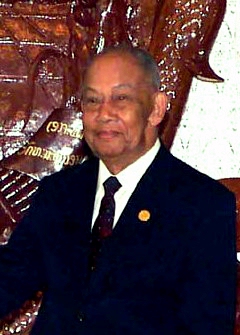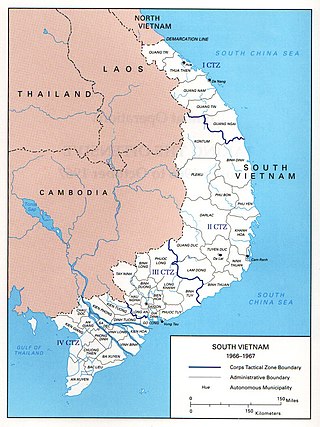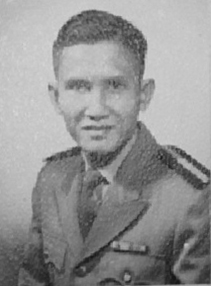Related Research Articles

The People's Army of Vietnam (PAVN), officially the Vietnam People's Army, also recognized as the Vietnamese Army or the People's Army, is the national military force of the Socialist Republic of Vietnam and the armed wing of the ruling Communist Party of Vietnam (CPV). The PAVN is a part of the Vietnam People's Armed Forces and includes: Ground Force, Navy, Air Force, Border Guard and Coast Guard. Vietnam does not have a separate Ground Force or Army service. All ground troops, army corps, military districts and special forces belong to the Ministry of National Defence, directly under the command of the CPV Central Military Commission, the Minister of National Defence, and the General Staff of the Vietnam People's Army. The military flag of the PAVN is the National flag of the Socialist Republic of Vietnam defaced with the motto Quyết thắng added in yellow at the top left.

The Vietnam War was a conflict in Vietnam, Laos, and Cambodia from 1 November 1955 to the fall of Saigon on 30 April 1975. It was the second of the Indochina Wars and was a major conflict of the Cold War. While the war was officially fought between North Vietnam and South Vietnam, the north was supported by the Soviet Union, China, and other communist states, while the south was supported by the United States and other anti-communist allies, making the war a proxy war between the United States and the Soviet Union. It lasted almost 20 years, with direct U.S. military involvement ending in 1973. The conflict also spilled over into neighboring states, exacerbating the Laotian Civil War and the Cambodian Civil War, which ended with all three countries officially becoming communist states by 1976.

South Vietnam, officially the Republic of Vietnam, was a country in Southeast Asia that existed from 1955 to 1975, the period when the southern portion of Vietnam was a member of the Western Bloc during part of the Cold War after the 1954 division of Vietnam. It first received international recognition in 1949 as the State of Vietnam within the French Union, with its capital at Saigon, before becoming a republic in 1955. South Vietnam was bordered by North Vietnam to the north, Laos to the northwest, Cambodia to the southwest, and Thailand across the Gulf of Thailand to the southwest. Its sovereignty was recognized by the United States and 87 other nations, though it failed to gain admission into the United Nations as a result of a Soviet veto in 1957. It was succeeded by the Republic of South Vietnam in 1975. In 1976, the Republic of South Vietnam and North Vietnam merged to form the Socialist Republic of Vietnam.

The Viet Cong was an epithet and umbrella term to call the communist-driven armed movement and united front organization in South Vietnam, Laos and Cambodia. Formally organized as and led by the National Liberation Front of South Vietnam, it fought under the direction of North Vietnam against the South Vietnamese and United States governments during the Vietnam War. The organization had both guerrilla and regular army units, as well as a network of cadres who organized and mobilized peasants in the territory the Viet Cong controlled. During the war, communist fighters and some anti-war activists claimed that the Viet Cong was an insurgency indigenous to the South that represented the legitimate rights of people in South Vietnam, while the U.S. and South Vietnamese governments portrayed the group as a tool of North Vietnam. It was later conceded by the modern Vietnamese communist leadership that the movement was actually under the North Vietnamese political and military leadership, aiming to unify Vietnam under a single banner.

The Army of the Republic of Vietnam composed the ground forces of the South Vietnamese military from its inception in 1955 to the Fall of Saigon in April 1975. At the ARVN's peak, an estimated 1 in 9 citizens of South Vietnam were enlisted, composed of Regular Forces and the more voluntary Regional Forces and the Popular Force militias. It is estimated to have suffered 1,394,000 casualties during the Vietnam War.

The Pathet Lao, officially the Lao People's Liberation Army, was a communist political movement and organization in Laos, formed in the mid-20th century. The group ultimately conquered the entire country in 1975, after the Laotian Civil War. The Pathet Lao were always closely associated with Vietnamese communists and North Vietnam. During the civil war, it was effectively organized, equipped and even led by the People's Army of Vietnam (PAVN). They fought against the anti-communist forces in the Vietnam War. Eventually, the term became the generic name for Laotian communists. Under orders from Mao Zedong, the People's Liberation Army provided 115,000 guns, 920,000 grenades and 170 million bullets, and trained more than 700 of its military officers.

The Cambodian Civil War was a civil war in Cambodia fought between the forces of the Communist Party of Kampuchea against the government forces of the Kingdom of Cambodia and, after October 1970, the Khmer Republic, which had succeeded the kingdom.

General Khamtai Siphandone is a Laotian politician who was Chairman of the Lao People's Revolutionary Party from 24 November 1992 to 21 March 2006 and President of Laos from 24 February 1998 to 8 June 2006, when he was replaced by Choummaly Sayasone. He was a member of the Communist Party of Indochina in 1954 and a member of the Central Committee of the Lao People's Revolutionary Party in 1956.

Vietnamization was a policy of the Richard Nixon administration to end U.S. involvement in the Vietnam War through a program to "expand, equip, and train South Vietnamese forces and assign to them an ever-increasing combat role, at the same time steadily reducing the number of U.S. combat troops". Brought on by the Viet Cong's Tet Offensive, the policy referred to U.S. combat troops specifically in the ground combat role, but did not reject combat by the U.S. Air Force, as well as the support to South Vietnam, consistent with the policies of U.S. foreign military assistance organizations. U.S. citizens' mistrust of their government that had begun after the offensive worsened with the release of news about U.S. soldiers massacring civilians at My Lai (1968), the invasion of Cambodia (1970), and the leaking of the Pentagon Papers (1971).

The Cambodian campaign was a series of military operations conducted in eastern Cambodia in mid-1970 by South Vietnam and the United States as an expansion of the Vietnam War and the Cambodian Civil War. Thirteen operations were conducted by the Army of the Republic of Vietnam (ARVN) between April 29 and July 22 and by U.S. forces between May 1 and June 30, 1970.

The 1975 spring offensive, officially known as the general offensive and uprising of spring 1975, was the final North Vietnamese campaign in the Vietnam War that led to the capitulation of Republic of Vietnam. After the initial success capturing Phước Long Province, the North Vietnamese leadership increased the scope of the People's Army of Vietnam's (PAVN) offensive and captured and held the key Central Highlands city of Buôn Ma Thuột between 10 and 18 March. These operations were intended to be preparatory to launching a general offensive in 1976.

Lê Văn Hưng was an infantry general of the Army of the Republic of Vietnam.

Central Office for South Vietnam, officially known as the Central Executive Committee of the People's Revolutionary Party from 1962 until its dissolution in 1976, was the American term for the North Vietnamese political and military headquarters inside South Vietnam during the Vietnam War. It was envisaged as being in overall command of the communist effort in the southern half of the Republic of Vietnam, which included the efforts of both People's Army of Vietnam (PAVN), the Viet Cong, and the People's Revolutionary Party. Some doubted its existence but in his memoirs the American commander in South Vietnam, General William Westmoreland, spoke of it as something whose existence and importance were not in doubt.

Cao Văn Viên was a four-star army general in the Army of the Republic of Vietnam during the Vietnam War. He rose to the position of Chairman of the South Vietnamese Joint General Staff. Considered one of "the most gifted" of South Vietnam's military leaders, he was previously called an "absolute key figure" and one of "the most important Vietnamese military leaders" in the U.S.-led fighting during the Vietnam War. Along with Trần Thiện Khiêm he was one of only two four-star generals in the entire history of South Vietnam.

South Vietnam was in political chaos during much of the year, as generals competed for power and Buddhists protested against the government. The Viet Cong (VC) communist guerrillas expanded their operations and defeated the South Vietnamese Army of the Republic of Vietnam (ARVN) in many battles. North Vietnam made a definitive judgement in January to assist the VC insurgency with men and material. In November, North Vietnam ordered the People's Army of Vietnam (PAVN) to infiltrate units into South Vietnam and undertake joint military operations with the VC.

1975 marked the end of the Vietnam War. The North Vietnamese People's Army of Vietnam (PAVN) launched the Spring Offensive in March; the South Vietnamese Army of the Republic of Vietnam (ARVN) was quickly defeated. The North Vietnamese captured Saigon on April 30, accepting the surrender of South Vietnam. In the final days of the war, the United States, which had supported South Vietnam for many years, carried out an emergency evacuation of its civilian and military personnel and more than 130,000 Vietnamese.
Nguyễn Vĩnh Nghi was a Lieutenant general in the South Vietnamese Army of the Republic of Vietnam (ARVN).

After World War II and the collapse of Vietnam's monarchy, France attempted to re-establish its colonial rule but was ultimately defeated in the First Indo-China War. The Geneva Accords in 1954 partitioned the country temporarily in two with a promise of democratic elections in 1956 to reunite the country. The United States and South Vietnam insisted on United Nations supervision of any election to prevent fraud, which the Soviet Union and North Vietnam refused. North and South Vietnam therefore remained divided until the Vietnam War ended with the Fall of Saigon in 1975.

Nguyễn Hữu Hạnh was a Vietnamese military officer of South Vietnam during the Vietnam War, rising to the rank of Brigadier General.